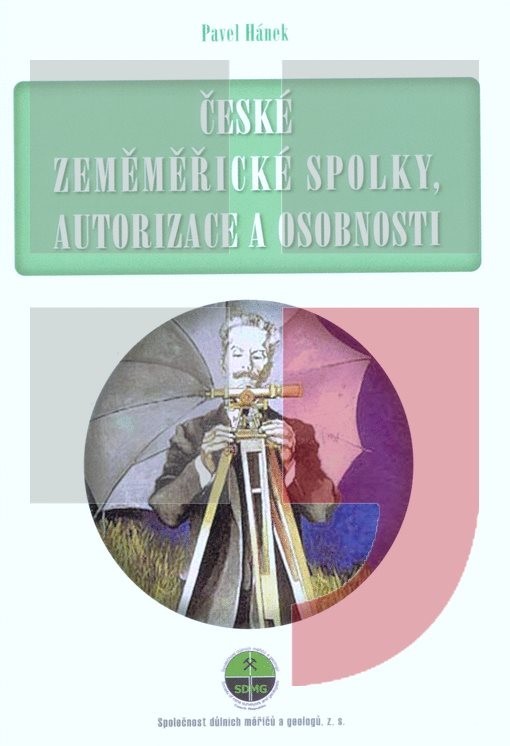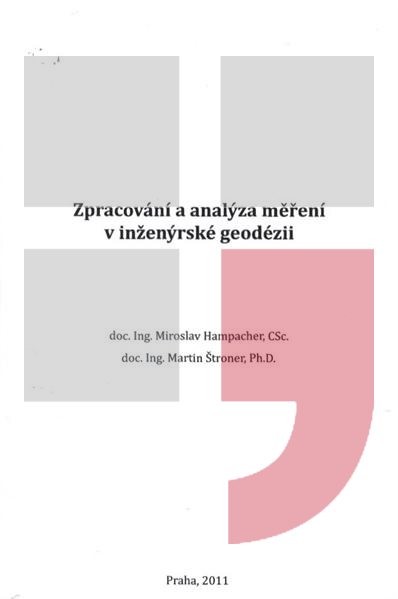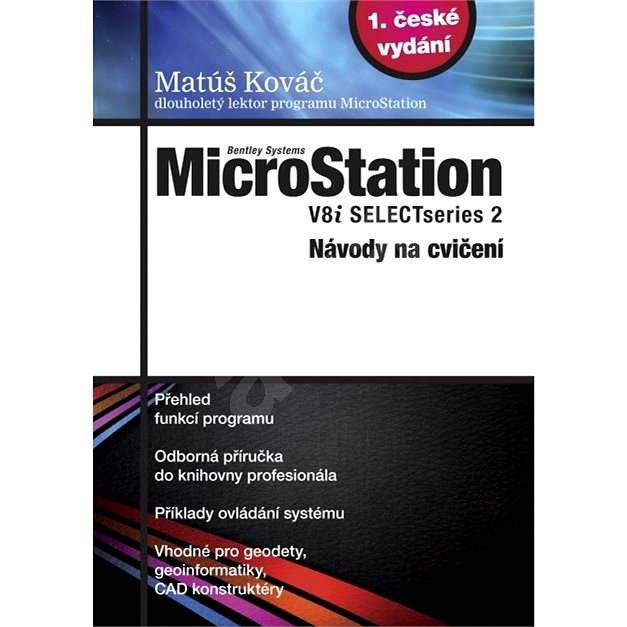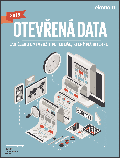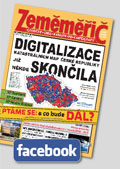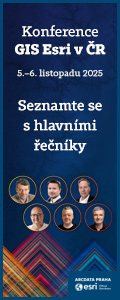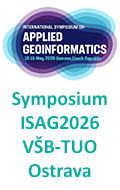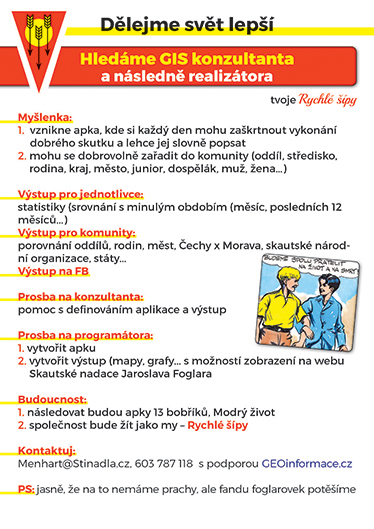zprávy
zdroje zpráv:20160421-nová výběrová řízení na vedoucí oddělení ČÚZK
21.4.2016 12:51 ČÚZK - předpisy a opatření Oznámení o vyhlášení výběrového řízení na služební místa vedoucího oddělení řízení územních orgánů, vedoucího oddělení řízení projektů, informatiky a koncepcí, vedoucího oddělení řízení projektů a rozvoje ISKN a vedoucího oddělení metodiky zeměměřictví a katastru - informace zde.20160421-nová výběrová řízení na vedoucí oddělení ČÚZK
21.4.2016 12:51 ČÚZK /Aktuality-resort/20160421-vedouci-odd-riz-uz-organu,vedouci-odd-riz20160421-nová výběrová řízení na vedoucí oddělení ČÚZK
21.4.2016 12:51 ČÚZK - předpisy a opatření Oznámení o vyhlášení výběrového řízení na služební místa vedoucího oddělení řízení územních orgánů, vedoucího oddělení řízení projektů, informatiky a koncepcí, vedoucího oddělení řízení projektů a rozvoje ISKN a vedoucího oddělení metodiky zeměměřictví a katastru.20160421-nová výběrová řízení na vedoucí oddělení ČÚZK
21.4.2016 12:51 ČÚZK - předpisy a opatření /Aktuality-resort/20160421-vedouci-odd-riz-uz-organu,vedouci-odd-rizVedoucí oddělení řízení územních orgánů
21.4.2016 12:43 ČÚZK - předpisy a opatření /Urady/Cesky-urad-zememericky-a-katastralni/Uredni-deska/Oznameni-a-jina-uredni-sdeleni/Volna-mista/Vedouci-oddeleni-rizeni-uzemnich-organuVedoucí oddělení řízení územních orgánů
21.4.2016 12:43 ČÚZK /Urady/Cesky-urad-zememericky-a-katastralni/Uredni-deska/Oznameni-a-jina-uredni-sdeleni/Volna-mista/Vedouci-oddeleni-rizeni-uzemnich-organuVedoucí oddělení řízení územních orgánů
21.4.2016 12:43 ČÚZK - volná místa /Urady/Cesky-urad-zememericky-a-katastralni/Uredni-deska/Oznameni-a-jina-uredni-sdeleni/Volna-mista/Vedouci-oddeleni-rizeni-uzemnich-organuVedoucí oddělení řízení projektů a rozvoje ISKN
21.4.2016 12:41 ČÚZK /Urady/Cesky-urad-zememericky-a-katastralni/Uredni-deska/Oznameni-a-jina-uredni-sdeleni/Volna-mista/Vedouci-oddeleni-rizeni-projektu-a-rozvoje-ISKNVedoucí oddělení řízení projektů a rozvoje ISKN
21.4.2016 12:41 ČÚZK - volná místa /Urady/Cesky-urad-zememericky-a-katastralni/Uredni-deska/Oznameni-a-jina-uredni-sdeleni/Volna-mista/Vedouci-oddeleni-rizeni-projektu-a-rozvoje-ISKNVedoucí oddělení řízení projektů a rozvoje ISKN
21.4.2016 12:41 ČÚZK - předpisy a opatření /Urady/Cesky-urad-zememericky-a-katastralni/Uredni-deska/Oznameni-a-jina-uredni-sdeleni/Volna-mista/Vedouci-oddeleni-rizeni-projektu-a-rozvoje-ISKNVedoucí oddělení řízení projektů, informatiky a koncepcí
21.4.2016 12:40 ČÚZK - předpisy a opatření /Urady/Cesky-urad-zememericky-a-katastralni/Uredni-deska/Oznameni-a-jina-uredni-sdeleni/Volna-mista/Vedouci-oddeleni-rizeni-projektu,-informatiky-a-koVedoucí oddělení řízení projektů, informatiky a koncepcí
21.4.2016 12:40 ČÚZK - volná místa /Urady/Cesky-urad-zememericky-a-katastralni/Uredni-deska/Oznameni-a-jina-uredni-sdeleni/Volna-mista/Vedouci-oddeleni-rizeni-projektu,-informatiky-a-koVedoucí oddělení řízení projektů, informatiky a koncepcí
21.4.2016 12:40 ČÚZK /Urady/Cesky-urad-zememericky-a-katastralni/Uredni-deska/Oznameni-a-jina-uredni-sdeleni/Volna-mista/Vedouci-oddeleni-rizeni-projektu,-informatiky-a-koVedoucí oddělení metodiky zeměměřictví a katastru
21.4.2016 12:37 ČÚZK - volná místa /Urady/Cesky-urad-zememericky-a-katastralni/Uredni-deska/Oznameni-a-jina-uredni-sdeleni/Volna-mista/Vedouci-oddeleni-metodiky-zememerictvi-a-katastruVedoucí oddělení metodiky zeměměřictví a katastru
21.4.2016 12:37 ČÚZK /Urady/Cesky-urad-zememericky-a-katastralni/Uredni-deska/Oznameni-a-jina-uredni-sdeleni/Volna-mista/Vedouci-oddeleni-metodiky-zememerictvi-a-katastruVedoucí oddělení metodiky zeměměřictví a katastru
21.4.2016 12:37 ČÚZK - předpisy a opatření /Urady/Cesky-urad-zememericky-a-katastralni/Uredni-deska/Oznameni-a-jina-uredni-sdeleni/Volna-mista/Vedouci-oddeleni-metodiky-zememerictvi-a-katastruTerénní cvičení a exkurze – jaro 2016
21.4.2016 12:01 Katedra geografie UP Olomouc Informace k terénním cvičením a exkurzím budou postupně přidávány na web katedry, odkazy k nim najdete v níže umístěné tabulce od chvíle, kdy budou zveřejněny. Uvedené zálohy noste sekretářce katedry, paní Věře Háblové v jejích úředních hodinách a v přesném obnosu, rovnou přitom se svým jménem hlaste, na kterou akci jdete zálohu složit.Datum
Předmět
Podrobnosti
Terénní cvičení
22.–24. 4. 2016
KGG/TCSG
TC ze sociální a ekonomické geografie
25.–28. 4. 2016
KGG/TCRG1
TC z regionální geografie 1
29. 4.–3. 5. 2016
KGG/TCRG2
TC z regionální geografie 2
4.–6. 5. 2016
KGG/TCFG
TC z fyzické geografie
Exkurze
9.–13. 5. 2016
KGG/KGEX
Exkurze západní Čechy
10.–14. 5. 2016
KGG/GPCR
Geografie v praxi ČR – exkurze SV Čechy
30. 5.–3. 6. 2016
KGG/ZGEX
Zahraniční exkurze Rakousko
18.–23. 6. 2016
KGG/EEI
Exkurze do evropských institucí
Na jaké uzavírky silnic můžete
21.4.2016 12:00 Jihočeský kraj Na jaké uzavírky silnic můžete letos při svých cestách Jihočeským krajem narazit? Na to Vám odpoví interaktivní mapa zobrazující plánované investiční akce Jihočeského kraje a Správy a údržby silnic JčK na silnicích II. a III. třídy pro rok 2016.Na jaké uzavírky silnic můžete
21.4.2016 12:00 Jihočeský kraj Na jaké uzavírky silnic můžete letos při svých cestách Jihočeským krajem narazit? Na to Vám odpoví interaktivní mapa (http://geoportal.kraj-jihocesky.gov.cz/gs/doprava/) zobrazující plánované investiční akce Jihočeského kraje a Správy a údržby silnic JčK na silnicích II. a III. třídy pro rok 2016.ČGS – Cestovatelský úterek 26. 4. 2016 (Zanzibar)
21.4.2016 10:04 Katedra geografie UP Olomouc Zveme Vás na přednášku v cyklu Cestovatelské úterkyHakuna matata: Zanzibar všemi smysly
která se uskuteční v úterý 26. dubna 2016 od 18.30 do 20.00 na učebně LP 2005. Přednáší Jíří Preis (pozvánka).
Hexagon Safety & Infrastructure Releases Intergraph Damage Assessment for Electric Utility Companies
21.4.2016 10:00 Hexagon Safety & InfrastructureHexagon Safety & Infrastructure has released Intergraph Damage Assessment, an application that enables end-to-end automation of the entire post-storm damage assessment process. Intergraph Damage Assessment can be used for simple outage patrols, as well as in times of devastating storm damage, making it an everyday solution that maximizes return on investment for electric utility companies.
Intergraph Damage Assessment’s integrated components originate in the storm room and extend to the field and back for a complete, automated solution. Supervisors can assign assessment work and visualize and analyse up-to-date data from a web-based application. Field crews using tablets can perform assessments against GIS network facility data and send results back in real-time.
Unlike disaster documentation systems, Intergraph Damage Assessment is specific to utility workflows, and unlike other damage assessment applications, it integrates with any geographic information system (GIS) or outage management system (OMS), featuring both a field application and supervisory dashboard for end-to-end workflows.
“Intergraph Damage Assessment automates the complete damage assessment process, helping utility companies identify storm-affected areas, determine proper staffing levels and obtain feedback on physical damage in real time,” said Eric Charette, executive manager of utilities, Hexagon Safety & Infrastructure. “Dispatchers stay better informed on the extent of damage, while storm managers can track progress. With Intergraph Damage Assessment, better information from the field ultimately leads to more accurate restoration times.”
Expectations to improve customer service and reduce restoration times is at an all-time high for electric utility companies. “Sending assessors out in advance to conduct Damage Assessment helps prioritize the hardest hit areas so that we can focus the deployment of our lineman on rebuilding the grid,” said Len Socha, senior outage management engineer, Wisconsin Public Service Corp.
However, most companies’ existing processes for damage assessment involve manual, paper-based data collection using outdated, printed map books or custom, in-house applications. They provide little real-time feedback to the storm supervisor during the assessment process, and any information collected must be manually entered into the OMS.
Intergraph Damage Assessment overcomes these hurdles. Within Intergraph Damage Assessment, a web-based application displays the location of outages, field crews and network facilities and enables supervisors to assign work by geographic areas. A tablet-based mobile application uses web services to provide views of outages, crews and GIS facility information as a layer on top of commercial maps, which enables workers to collect data in the field for comprehensive damage assessment. Using the web-based application back in the storm room, supervisors can view that information and run reports and analysis to determine the extent of damage and aid in restoration strategy. Server-side event processing and industry-standard messaging enable integration with other systems for collection results, including materials required to rebuild the network, leading to real-time intelligent decision making, which is not possible when using outdated paper maps.
Extensive hands-on field testing of Intergraph Damage Assessment was conducted as part of the certification cycle. “We felt it was vital to get Intergraph Damage Assessment in the hands of users to test the application in the field under real-world conditions that you can’t simulate in the office,” Charette said.
The release of Intergraph Damage Assessment coincides with the Midwest Mutual Assistance Group Conference in Chicago, Illinois. Hexagon Safety & Infrastructure is a sponsor of the conference, which meets to discuss electric utility resource management, storm restoration techniques and damage assessment.
Hexagon Safety & Infrastructure helps utilities and communications companies achieve greater reliability, increase efficiency and fulfill the expectations of customers, shareholders and regulators. A pioneer in the development and application of location-based technology, Hexagon Safety & Infrastructure provides solutions to hundreds of utilities and communications customers around the globe, supporting network engineering, network operations, customer services, sales and marketing and physical security.
Hexagon Safety & Infrastructure Releases Intergraph Damage Assessment for Electric Utility Companies
21.4.2016 10:00 Hexagon Safety & InfrastructureHexagon Safety & Infrastructure has released Intergraph Damage Assessment, an application that enables end-to-end automation of the entire post-storm damage assessment process. Intergraph Damage Assessment can be used for simple outage patrols, as well as in times of devastating storm damage, making it an everyday solution that maximizes return on investment for electric utility companies.
Intergraph Damage Assessment’s integrated components originate in the storm room and extend to the field and back for a complete, automated solution. Supervisors can assign assessment work and visualize and analyse up-to-date data from a web-based application. Field crews using tablets can perform assessments against GIS network facility data and send results back in real-time.
Unlike disaster documentation systems, Intergraph Damage Assessment is specific to utility workflows, and unlike other damage assessment applications, it integrates with any geographic information system (GIS) or outage management system (OMS), featuring both a field application and supervisory dashboard for end-to-end workflows.
“Intergraph Damage Assessment automates the complete damage assessment process, helping utility companies identify storm-affected areas, determine proper staffing levels and obtain feedback on physical damage in real time,” said Eric Charette, executive manager of utilities, Hexagon Safety & Infrastructure. “Dispatchers stay better informed on the extent of damage, while storm managers can track progress. With Intergraph Damage Assessment, better information from the field ultimately leads to more accurate restoration times.”
Expectations to improve customer service and reduce restoration times is at an all-time high for electric utility companies. “Sending assessors out in advance to conduct Damage Assessment helps prioritize the hardest hit areas so that we can focus the deployment of our lineman on rebuilding the grid,” said Len Socha, senior outage management engineer, Wisconsin Public Service Corp.
However, most companies’ existing processes for damage assessment involve manual, paper-based data collection using outdated, printed map books or custom, in-house applications. They provide little real-time feedback to the storm supervisor during the assessment process, and any information collected must be manually entered into the OMS.
Intergraph Damage Assessment overcomes these hurdles. Within Intergraph Damage Assessment, a web-based application displays the location of outages, field crews and network facilities and enables supervisors to assign work by geographic areas. A tablet-based mobile application uses web services to provide views of outages, crews and GIS facility information as a layer on top of commercial maps, which enables workers to collect data in the field for comprehensive damage assessment. Using the web-based application back in the storm room, supervisors can view that information and run reports and analysis to determine the extent of damage and aid in restoration strategy. Server-side event processing and industry-standard messaging enable integration with other systems for collection results, including materials required to rebuild the network, leading to real-time intelligent decision making, which is not possible when using outdated paper maps.
Extensive hands-on field testing of Intergraph Damage Assessment was conducted as part of the certification cycle. “We felt it was vital to get Intergraph Damage Assessment in the hands of users to test the application in the field under real-world conditions that you can’t simulate in the office,” Charette said.
The release of Intergraph Damage Assessment coincides with the Midwest Mutual Assistance Group Conference in Chicago, Illinois. Hexagon Safety & Infrastructure is a sponsor of the conference, which meets to discuss electric utility resource management, storm restoration techniques and damage assessment.
Hexagon Safety & Infrastructure helps utilities and communications companies achieve greater reliability, increase efficiency and fulfill the expectations of customers, shareholders and regulators. A pioneer in the development and application of location-based technology, Hexagon Safety & Infrastructure provides solutions to hundreds of utilities and communications customers around the globe, supporting network engineering, network operations, customer services, sales and marketing and physical security.
Hexagon Safety & Infrastructure Releases Intergraph Damage Assessment for Electric Utility Companies
21.4.2016 10:00 Hexagon Safety & InfrastructureHexagon Safety & Infrastructure has released Intergraph Damage Assessment, an application that enables end-to-end automation of the entire post-storm damage assessment process. Intergraph Damage Assessment can be used for simple outage patrols, as well as in times of devastating storm damage, making it an everyday solution that maximizes return on investment for electric utility companies.
Intergraph Damage Assessment’s integrated components originate in the storm room and extend to the field and back for a complete, automated solution. Supervisors can assign assessment work and visualize and analyse up-to-date data from a web-based application. Field crews using tablets can perform assessments against GIS network facility data and send results back in real-time.
Unlike disaster documentation systems, Intergraph Damage Assessment is specific to utility workflows, and unlike other damage assessment applications, it integrates with any geographic information system (GIS) or outage management system (OMS), featuring both a field application and supervisory dashboard for end-to-end workflows.
“Intergraph Damage Assessment automates the complete damage assessment process, helping utility companies identify storm-affected areas, determine proper staffing levels and obtain feedback on physical damage in real time,” said Eric Charette, executive manager of utilities, Hexagon Safety & Infrastructure. “Dispatchers stay better informed on the extent of damage, while storm managers can track progress. With Intergraph Damage Assessment, better information from the field ultimately leads to more accurate restoration times.”
Expectations to improve customer service and reduce restoration times is at an all-time high for electric utility companies. “Sending assessors out in advance to conduct Damage Assessment helps prioritize the hardest hit areas so that we can focus the deployment of our lineman on rebuilding the grid,” said Len Socha, senior outage management engineer, Wisconsin Public Service Corp.
However, most companies’ existing processes for damage assessment involve manual, paper-based data collection using outdated, printed map books or custom, in-house applications. They provide little real-time feedback to the storm supervisor during the assessment process, and any information collected must be manually entered into the OMS.
Intergraph Damage Assessment overcomes these hurdles. Within Intergraph Damage Assessment, a web-based application displays the location of outages, field crews and network facilities and enables supervisors to assign work by geographic areas. A tablet-based mobile application uses web services to provide views of outages, crews and GIS facility information as a layer on top of commercial maps, which enables workers to collect data in the field for comprehensive damage assessment. Using the web-based application back in the storm room, supervisors can view that information and run reports and analysis to determine the extent of damage and aid in restoration strategy. Server-side event processing and industry-standard messaging enable integration with other systems for collection results, including materials required to rebuild the network, leading to real-time intelligent decision making, which is not possible when using outdated paper maps.
Extensive hands-on field testing of Intergraph Damage Assessment was conducted as part of the certification cycle. “We felt it was vital to get Intergraph Damage Assessment in the hands of users to test the application in the field under real-world conditions that you can’t simulate in the office,” Charette said.
The release of Intergraph Damage Assessment coincides with the Midwest Mutual Assistance Group Conference in Chicago, Illinois. Hexagon Safety & Infrastructure is a sponsor of the conference, which meets to discuss electric utility resource management, storm restoration techniques and damage assessment.
Hexagon Safety & Infrastructure helps utilities and communications companies achieve greater reliability, increase efficiency and fulfill the expectations of customers, shareholders and regulators. A pioneer in the development and application of location-based technology, Hexagon Safety & Infrastructure provides solutions to hundreds of utilities and communications customers around the globe, supporting network engineering, network operations, customer services, sales and marketing and physical security.
Hexagon Safety & Infrastructure Releases Intergraph Damage Assessment for Electric Utility Companies
21.4.2016 10:00 Hexagon Safety & InfrastructureHexagon Safety & Infrastructure has released Intergraph Damage Assessment, an application that enables end-to-end automation of the entire post-storm damage assessment process. Intergraph Damage Assessment can be used for simple outage patrols, as well as in times of devastating storm damage, making it an everyday solution that maximizes return on investment for electric utility companies.
Intergraph Damage Assessment’s integrated components originate in the storm room and extend to the field and back for a complete, automated solution. Supervisors can assign assessment work and visualize and analyse up-to-date data from a web-based application. Field crews using tablets can perform assessments against GIS network facility data and send results back in real-time.
Unlike disaster documentation systems, Intergraph Damage Assessment is specific to utility workflows, and unlike other damage assessment applications, it integrates with any geographic information system (GIS) or outage management system (OMS), featuring both a field application and supervisory dashboard for end-to-end workflows.
“Intergraph Damage Assessment automates the complete damage assessment process, helping utility companies identify storm-affected areas, determine proper staffing levels and obtain feedback on physical damage in real time,” said Eric Charette, executive manager of utilities, Hexagon Safety & Infrastructure. “Dispatchers stay better informed on the extent of damage, while storm managers can track progress. With Intergraph Damage Assessment, better information from the field ultimately leads to more accurate restoration times.”
Expectations to improve customer service and reduce restoration times is at an all-time high for electric utility companies. “Sending assessors out in advance to conduct Damage Assessment helps prioritize the hardest hit areas so that we can focus the deployment of our lineman on rebuilding the grid,” said Len Socha, senior outage management engineer, Wisconsin Public Service Corp.
However, most companies’ existing processes for damage assessment involve manual, paper-based data collection using outdated, printed map books or custom, in-house applications. They provide little real-time feedback to the storm supervisor during the assessment process, and any information collected must be manually entered into the OMS.
Intergraph Damage Assessment overcomes these hurdles. Within Intergraph Damage Assessment, a web-based application displays the location of outages, field crews and network facilities and enables supervisors to assign work by geographic areas. A tablet-based mobile application uses web services to provide views of outages, crews and GIS facility information as a layer on top of commercial maps, which enables workers to collect data in the field for comprehensive damage assessment. Using the web-based application back in the storm room, supervisors can view that information and run reports and analysis to determine the extent of damage and aid in restoration strategy. Server-side event processing and industry-standard messaging enable integration with other systems for collection results, including materials required to rebuild the network, leading to real-time intelligent decision making, which is not possible when using outdated paper maps.
Extensive hands-on field testing of Intergraph Damage Assessment was conducted as part of the certification cycle. “We felt it was vital to get Intergraph Damage Assessment in the hands of users to test the application in the field under real-world conditions that you can’t simulate in the office,” Charette said.
The release of Intergraph Damage Assessment coincides with the Midwest Mutual Assistance Group Conference in Chicago, Illinois. Hexagon Safety & Infrastructure is a sponsor of the conference, which meets to discuss electric utility resource management, storm restoration techniques and damage assessment.
Hexagon Safety & Infrastructure helps utilities and communications companies achieve greater reliability, increase efficiency and fulfill the expectations of customers, shareholders and regulators. A pioneer in the development and application of location-based technology, Hexagon Safety & Infrastructure provides solutions to hundreds of utilities and communications customers around the globe, supporting network engineering, network operations, customer services, sales and marketing and physical security.
Hexagon Safety & Infrastructure Releases Intergraph Damage Assessment for Electric Utility Companies
21.4.2016 10:00 Hexagon Safety & InfrastructureHexagon Safety & Infrastructure has released Intergraph Damage Assessment, an application that enables end-to-end automation of the entire post-storm damage assessment process. Intergraph Damage Assessment can be used for simple outage patrols, as well as in times of devastating storm damage, making it an everyday solution that maximizes return on investment for electric utility companies.
Intergraph Damage Assessment’s integrated components originate in the storm room and extend to the field and back for a complete, automated solution. Supervisors can assign assessment work and visualize and analyse up-to-date data from a web-based application. Field crews using tablets can perform assessments against GIS network facility data and send results back in real-time.
Unlike disaster documentation systems, Intergraph Damage Assessment is specific to utility workflows, and unlike other damage assessment applications, it integrates with any geographic information system (GIS) or outage management system (OMS), featuring both a field application and supervisory dashboard for end-to-end workflows.
“Intergraph Damage Assessment automates the complete damage assessment process, helping utility companies identify storm-affected areas, determine proper staffing levels and obtain feedback on physical damage in real time,” said Eric Charette, executive manager of utilities, Hexagon Safety & Infrastructure. “Dispatchers stay better informed on the extent of damage, while storm managers can track progress. With Intergraph Damage Assessment, better information from the field ultimately leads to more accurate restoration times.”
Expectations to improve customer service and reduce restoration times is at an all-time high for electric utility companies. “Sending assessors out in advance to conduct Damage Assessment helps prioritize the hardest hit areas so that we can focus the deployment of our lineman on rebuilding the grid,” said Len Socha, senior outage management engineer, Wisconsin Public Service Corp.
However, most companies’ existing processes for damage assessment involve manual, paper-based data collection using outdated, printed map books or custom, in-house applications. They provide little real-time feedback to the storm supervisor during the assessment process, and any information collected must be manually entered into the OMS.
Intergraph Damage Assessment overcomes these hurdles. Within Intergraph Damage Assessment, a web-based application displays the location of outages, field crews and network facilities and enables supervisors to assign work by geographic areas. A tablet-based mobile application uses web services to provide views of outages, crews and GIS facility information as a layer on top of commercial maps, which enables workers to collect data in the field for comprehensive damage assessment. Using the web-based application back in the storm room, supervisors can view that information and run reports and analysis to determine the extent of damage and aid in restoration strategy. Server-side event processing and industry-standard messaging enable integration with other systems for collection results, including materials required to rebuild the network, leading to real-time intelligent decision making, which is not possible when using outdated paper maps.
Extensive hands-on field testing of Intergraph Damage Assessment was conducted as part of the certification cycle. “We felt it was vital to get Intergraph Damage Assessment in the hands of users to test the application in the field under real-world conditions that you can’t simulate in the office,” Charette said.
The release of Intergraph Damage Assessment coincides with the Midwest Mutual Assistance Group Conference in Chicago, Illinois. Hexagon Safety & Infrastructure is a sponsor of the conference, which meets to discuss electric utility resource management, storm restoration techniques and damage assessment.
Hexagon Safety & Infrastructure helps utilities and communications companies achieve greater reliability, increase efficiency and fulfill the expectations of customers, shareholders and regulators. A pioneer in the development and application of location-based technology, Hexagon Safety & Infrastructure provides solutions to hundreds of utilities and communications customers around the globe, supporting network engineering, network operations, customer services, sales and marketing and physical security.
2016
21.4.2016 9:31 ČÚZK /Urady/Katastralni-urady/Katastralni-urady/Katastralni-urad-pro-Pardubicky-kraj/Casto-hledane-informace/Poskytovani-informaci-106-1999-Sb/Zverejneni-obsahu-informaci-poskytnutych-na-za-(1)/20162016
21.4.2016 9:31 ČÚZK - předpisy a opatření /Urady/Katastralni-urady/Katastralni-urady/Katastralni-urad-pro-Pardubicky-kraj/Casto-hledane-informace/Poskytovani-informaci-106-1999-Sb/Zverejneni-obsahu-informaci-poskytnutych-na-za-(1)/20162016
21.4.2016 9:31 ČÚZK - předpisy a opatření Katastrální úřad pro Pardubický krajZverejnení obsahu informací poskytnutých na žádost dle zákona c. 106/1999 Sb.
2016
odborný rada v oddělení metodiky a kontroly
21.4.2016 8:20 ČÚZK - volná místa /Urady/Katastralni-urady/Katastralni-urady/Katastralni-urad-pro-Jihomoravsky-kraj/Uredni-deska/Oznameni-a-jina-uredni-sdeleni/Volna-mista/odborny-rada-v-oddeleni-metodiky-a-kontrolyodborný rada v oddělení metodiky a kontroly
21.4.2016 8:20 ČÚZK - předpisy a opatření /Urady/Katastralni-urady/Katastralni-urady/Katastralni-urad-pro-Jihomoravsky-kraj/Uredni-deska/Oznameni-a-jina-uredni-sdeleni/Volna-mista/odborny-rada-v-oddeleni-metodiky-a-kontrolyodborný rada v oddělení metodiky a kontroly
21.4.2016 8:20 ČÚZK /Urady/Katastralni-urady/Katastralni-urady/Katastralni-urad-pro-Jihomoravsky-kraj/Uredni-deska/Oznameni-a-jina-uredni-sdeleni/Volna-mista/odborny-rada-v-oddeleni-metodiky-a-kontrolyodborný referent v oddělení právních vztahů k nemovitostem
21.4.2016 8:15 ČÚZK - předpisy a opatření /Urady/Katastralni-urady/Katastralni-urady/Katastralni-urad-pro-Jihomoravsky-kraj/Uredni-deska/Oznameni-a-jina-uredni-sdeleni/Volna-mista/odborny-referent-v-oddeleni-pravnich-vztahu-k-(5)odborný referent v oddělení právních vztahů k nemovitostem
21.4.2016 8:15 ČÚZK - volná místa /Urady/Katastralni-urady/Katastralni-urady/Katastralni-urad-pro-Jihomoravsky-kraj/Uredni-deska/Oznameni-a-jina-uredni-sdeleni/Volna-mista/odborny-referent-v-oddeleni-pravnich-vztahu-k-(5)odborný referent v oddělení právních vztahů k nemovitostem
21.4.2016 8:15 ČÚZK /Urady/Katastralni-urady/Katastralni-urady/Katastralni-urad-pro-Jihomoravsky-kraj/Uredni-deska/Oznameni-a-jina-uredni-sdeleni/Volna-mista/odborny-referent-v-oddeleni-pravnich-vztahu-k-(5)odborný referent v oddělení právních vztahů k nemovitostem
21.4.2016 8:08 ČÚZK - volná místa /Urady/Katastralni-urady/Katastralni-urady/Katastralni-urad-pro-Jihomoravsky-kraj/Uredni-deska/Oznameni-a-jina-uredni-sdeleni/Volna-mista/odborny-referent-v-oddeleni-pravnich-vztahu-k-(4)odborný referent v oddělení právních vztahů k nemovitostem
21.4.2016 8:08 ČÚZK /Urady/Katastralni-urady/Katastralni-urady/Katastralni-urad-pro-Jihomoravsky-kraj/Uredni-deska/Oznameni-a-jina-uredni-sdeleni/Volna-mista/odborny-referent-v-oddeleni-pravnich-vztahu-k-(4)odborný referent v oddělení právních vztahů k nemovitostem
21.4.2016 8:08 ČÚZK - předpisy a opatření /Urady/Katastralni-urady/Katastralni-urady/Katastralni-urad-pro-Jihomoravsky-kraj/Uredni-deska/Oznameni-a-jina-uredni-sdeleni/Volna-mista/odborny-referent-v-oddeleni-pravnich-vztahu-k-(4)rada/odborný rada v oddělení aktualizace KN
21.4.2016 8:01 ČÚZK - volná místa /Urady/Katastralni-urady/Katastralni-urady/Katastralni-urad-pro-Jihomoravsky-kraj/Uredni-deska/Oznameni-a-jina-uredni-sdeleni/Volna-mista/rada-odborny-rada-v-oddeleni-aktualizace-KNrada/odborný rada v oddělení aktualizace KN
21.4.2016 8:01 ČÚZK - předpisy a opatření /Urady/Katastralni-urady/Katastralni-urady/Katastralni-urad-pro-Jihomoravsky-kraj/Uredni-deska/Oznameni-a-jina-uredni-sdeleni/Volna-mista/rada-odborny-rada-v-oddeleni-aktualizace-KNrada/odborný rada v oddělení aktualizace KN
21.4.2016 8:01 ČÚZK /Urady/Katastralni-urady/Katastralni-urady/Katastralni-urad-pro-Jihomoravsky-kraj/Uredni-deska/Oznameni-a-jina-uredni-sdeleni/Volna-mista/rada-odborny-rada-v-oddeleni-aktualizace-KNDotazník pro poskytovatele dat o finančních modelech datového fondu klíčových prostorových informací
21.4.2016 7:00 Česká asociace pro geoinformaceTento dotazník byl vytvořen v rámci projektu Technologické agentury České republiky „Vypracování analytického návrhu modelu financování datového fondu klíčových prostorových informací“ řešeného pro Ministerstvo vnitra České republiky v návaznosti na Akční plán GeoInfoStrategie, jež byl schválen usnesením vlády ČR ze dne 8. července 2015 č. 539. První
Dotazník: Jaké je využití prostorových dat ve vaší organizaci?
21.4.2016 7:00 Česká asociace pro geoinformaceDotazník využití prostorových dat ve Vaší společnosti byl vytvořen v rámci projektu Technologické agentury České republiky „Vypracování analytického návrhu modelu financování datového fondu klíčových prostorových informací“ řešeného pro Ministerstvo vnitra České republiky v návaznosti na Akční plán GeoInfoStrategie, jež byl schválen usnesením vlády ČR
Gefos - prezentace ze setkání zákazníků
21.4.2016 7:00 Česká asociace pro geoinformace Na webu společnosti Gefos naleznete prezentace příspěvků z letošního Setkání. Pokud jste z jakéhokoli důvodu nemohli na akci dorazit, jistě nepohrdnete tímtoPamátkové zóny - bodová identifikace
21.4.2016 2:00 Cenia - Katalog metadat ČR - INSPIRE Definiční body památkových zón s připojenými základními atributy evidovanými v USKP (aplikaci Památkový katalog).Riparian Zones (Břehové zóny)
21.4.2016 2:00 Cenia - Katalog metadat ČR - INSPIRE Riparian Zones (Břehové zóny) jsou součástí služby Copernicus pro monitorování území. Obsahuje podrobné informace o využití území v okolí vodních toků a zmapovaných zelených lineárních prvků (Green Linear Elements) ve 39 evropských státech. Jedná se o vektorová data v měřítku cca 1 : 10 000, aktuálně dostupná za období 2010 - 2013. Technické specifikace jsou k dispozici na http://land.copernicus.eu/user-corner/technical-library, obecné informace na http://land.copernicus.eu.Památkové rezervace - vymezení rozsahu ochrany
21.4.2016 2:00 Cenia - Katalog metadat ČR - INSPIRE Plošná / polygonová vymezení rozsahu památkových rezervací s připojenými základními atributy evidovanými v USKP (aplikaci Památkový katalog).Památkové zóny - vymezení rozsahu ochrany
21.4.2016 2:00 Cenia - Katalog metadat ČR - INSPIRE Plošná / polygonová vymezení rozsahu památkových zón s připojenými základními atributy evidovanými v USKP (aplikaci Památkový katalog).Světové dědictví - bodová identifikace
21.4.2016 2:00 Cenia - Katalog metadat ČR - INSPIRE Definiční body statků zapsaných na Seznamu světového kulturního a přírodního dědictví UNESCO s připojenými základními atributy evidovanými v USKP (aplikaci Památkový katalog).Světové dědictví - vymezení rozsahu
21.4.2016 2:00 Cenia - Katalog metadat ČR - INSPIRE Plošná / polygonová vymezení rozsahu statků zapsaných na Seznamu světového kulturního a přírodního dědictví UNESCO s připojenými základními atributy evidovanými v USKP (aplikaci Památkový katalog).How UAVs have Impacted 3D Tech
20.4.2016 21:14 Bentley SystemsPress Coverage
Commercial UAV Expo
Read the articleMoving Beyond VR and AR with Greg Bentley
20.4.2016 19:19 Bentley SystemsPress Coverage
SPAR Point Group
Read the articleGIS a Mapa
20.4.2016 16:50 Blogující geomatici - FAV ZČU Než jsem šel na dnešní cvičení z Úvodu do GIS, kde probíráme topologická překrytí, našel jsem v RSS kanálech video, které vymezuje GIS vůči kartografii. A v tom videu m. j. řeší tu samou analýzu, co mi na cvičení (nalezení, kolik km silnic se nachází v lese). Ke shlédnutí doporučuji nejen studentům UGI ;-).Sentinel-1B in position for liftoff
20.4.2016 16:33 ESA Observing the Earth
With just two days to liftoff, the next Sentinel for Europe’s environmental monitoring programme in now poised high in the launch tower at Europe’s Spaceport in Kourou, French Guiana.
Družice Sentinel-1B je připravena na start
20.4.2016 15:31 Český Kosmický PortálJen dva dny před plánovaným startem byla nová družice Sentinel pro evropský program sledování životního prostředí GMES/Copernicus umístěna na startovací rampu kosmodromu Kourou (stát Francouzská Guayana).
Družice Sentinel-1B je připravena na start
20.4.2016 15:31 Český Kosmický PortálJen dva dny před plánovaným startem byla nová družice Sentinel pro evropský program sledování životního prostředí GMES/Copernicus umístěna na startovací rampu kosmodromu Kourou (stát Francouzská Guayana).
News Alert: Bentley Systems’ Eric Crivella Receives Fiatech STAR Award
20.4.2016 15:15 Bentley SystemsRecognized for Helping Drive Advanced Work Packaging’s Structure
and Designation as a Construction Industry Institute Best Practice
EXTON, Pa., U.S.A. – Bentley Systems, Incorporated, a leading global provider of comprehensive software solutions for advancing infrastructure, today announced that Eric Crivella, Bentley plant construction executive and industry sales director, was presented with a Fiatech 2015 Superior Technical Achievement Recognition (STAR) Award this month at the Celebration of Engineering & Technology Innovation gala in Austin, Texas. The STAR Award honors members whose leadership, commitment, participation, and personal dedication have helped advance the goals of Fiatech and benefited the capital projects industry at large. Crivella was recognized for his work on Fiatech’s Advanced Work Packaging (AWP) project.
Fiatech Executive Director Ray Topping said, “Eric Crivella has long advocated for and provided thought leadership in support of Advanced Work Packaging, beginning with the original advancements of WorkFace Planning. Recognizing a shortcoming in the practice of identifying and accessing the information resources needed to support AWP, he defined and was instrumental in launching a Fiatech AWP Information Mapping project (AIM) designed to overcome this constraint. Eric’s STAR Award is certainly well deserved for the leadership he provided on this crucially important work.”
Reg Hunter, senior program director, Fiatech, added, “Eric’s commitment to and active involvement in the advancement of work processes have been instrumental in driving not only the structure of AWP, but also the designation of AWP as a Construction Industry Institute (CII) best practice. He also has helped facilitate AWP’s accelerated reduction to actual practice in the industry, where cost reductions of over 15 percent have been consistently demonstrated.”
Harry Vitelli, Bentley Systems senior vice president, construction and field, project delivery, said, “Eric’s colleagues at Bentley Systems congratulate and join in thanking him for his work with Fiatech. Advanced Work Packaging has tremendous merit and potential, and I believe the project delivery community is being very well served by Fiatech’s, and Eric’s, advocacy for Advanced Work Packaging and its benefits.”
Wayne A. Crew, general secretary, National Academy of Construction, said, “Eric was an early believer that a framework encompassing initial planning and continuing through detailed design and construction installation would provide the industry a step change in the overall execution of capital projects. His passion, commitment, and energy have moved AWP from being a concept to a proven best practice. For this important achievement, Eric greatly deserves being distinguished with a STAR Award.”
Crivella has extensive subject matter expertise in AWP and WorkFace Planning, BIM strategies, and construction automation solutions. Prior to joining Bentley Systems, he was director of business development and co-founder of Common Point, which Bentley acquired in May 2008. In addition to his role at Bentley, Crivella serves on the board of advisors at the CII and is co-chair of the CII AWP Community of Practice.
About Fiatech
Fiatech is an international community of passionate stakeholders working together to lead global development and adoption of innovative practices and technologies to realize the highest business value throughout the life cycle of capital assets. For more information about Fiatech, visit www.fiatech.org.
Bentley Systems is a global leader in providing architects, engineers, geospatial professionals, constructors, and owner-operators with comprehensive software solutions for advancing the design, construction, and operations of infrastructure. Bentley users leverage information mobility across disciplines and throughout the infrastructure lifecycle to deliver better-performing projects and assets. Bentley solutions encompass MicroStation applications for information modeling, ProjectWise collaboration services to deliver integrated projects, and AssetWise operations services to achieve intelligent infrastructure – complemented by worldwide professional services and comprehensive managed services.
Founded in 1984, Bentley has more than 3,000 colleagues in over 50 countries, more than $600 million in annual revenues, and since 2008 has invested more than $1 billion in research, development, and acquisitions.
Additional information about Bentley is available at www.bentley.com and in Bentley’s annual report. For Bentley news as it happens, subscribe to an RSS feed of Bentley press releases and news alerts. Visit The Year in Infrastructure Conference website for highlights of Bentley’s premier thought-leadership event. To view a searchable collection of innovative infrastructure projects from the annual Be Inspired Awards, access Bentley’s Infrastructure Yearbooks. To access a professional networking site that enables members of the infrastructure community to connect, communicate, and learn from each other, visit Bentley Communities.
To download the Bentley Infrastructure 500 Top Owners ranking, a unique global compendium of the top public- and private-sector owners of infrastructure based on the value of their cumulative infrastructure investments, visit BI 500.
# # #
Bentley, the “B” Bentley logo, Be, MicroStation, and ProjectWise are either registered or unregistered trademarks or service marks of Bentley Systems, Incorporated or one of its direct or indirect wholly owned subsidiaries. All other brands and product names are trademarks of their respective owners.Watch Sentinel-1B launch
20.4.2016 14:40 ESA Observing the Earth
Follow the Sentinel-1B launch live from Europe’s Spaceport in French Guiana on 23 April. Streaming begins at 20:40 GMT (22:40 CEST), with liftoff scheduled at 21:02 GMT (23:02 CEST)
Watch Sentinel-1B launch
20.4.2016 14:40 ESA Observing the Earth
Follow the Sentinel-1B launch live from Europe’s Spaceport in French Guiana on 23 April. Streaming begins at 20:10 GMT (22:10 CEST), with liftoff scheduled at 21:02 GMT (23:02 CEST)
Follow the ESRIN event
20.4.2016 14:40 ESA Observing the Earth
Despite launch postponement, the ESRIN Sentinel-1B briefing event goes ahead. Watch live from 21:00 CEST (19:00 GMT)
vedoucí oddělení právních vztahů k nemovitostem
20.4.2016 14:02 ČÚZK /Urady/Katastralni-urady/Katastralni-urady/Katastralni-urad-pro-Stredocesky-kraj/Uredni-deska/Oznameni-a-jina-uredni-sdeleni/Volna-mista/vedouci-oddeleni-pravnich-vztahu-k-nemovitostem-(6vedoucí oddělení právních vztahů k nemovitostem
20.4.2016 14:02 ČÚZK - volná místa /Urady/Katastralni-urady/Katastralni-urady/Katastralni-urad-pro-Stredocesky-kraj/Uredni-deska/Oznameni-a-jina-uredni-sdeleni/Volna-mista/vedouci-oddeleni-pravnich-vztahu-k-nemovitostem-(6vedoucí oddělení právních vztahů k nemovitostem
20.4.2016 14:02 ČÚZK - předpisy a opatření /Urady/Katastralni-urady/Katastralni-urady/Katastralni-urad-pro-Stredocesky-kraj/Uredni-deska/Oznameni-a-jina-uredni-sdeleni/Volna-mista/vedouci-oddeleni-pravnich-vztahu-k-nemovitostem-(6vedoucí oddělení aktualizace katastru nemovitostí (2)
20.4.2016 14:00 ČÚZK - předpisy a opatření /Urady/Katastralni-urady/Katastralni-urady/Katastralni-urad-pro-Stredocesky-kraj/Uredni-deska/Oznameni-a-jina-uredni-sdeleni/Volna-mista/vedouci-oddeleni-aktualizace-katastru-nemovito-(2)vedoucí oddělení aktualizace katastru nemovitostí (2)
20.4.2016 14:00 ČÚZK - volná místa /Urady/Katastralni-urady/Katastralni-urady/Katastralni-urad-pro-Stredocesky-kraj/Uredni-deska/Oznameni-a-jina-uredni-sdeleni/Volna-mista/vedouci-oddeleni-aktualizace-katastru-nemovito-(2)vedoucí oddělení aktualizace katastru nemovitostí (2)
20.4.2016 14:00 ČÚZK /Urady/Katastralni-urady/Katastralni-urady/Katastralni-urad-pro-Stredocesky-kraj/Uredni-deska/Oznameni-a-jina-uredni-sdeleni/Volna-mista/vedouci-oddeleni-aktualizace-katastru-nemovito-(2)vrchní referent/rada oddělení aktualizace popisných informací katastru nemovitostí I.
20.4.2016 13:48 ČÚZK /Urady/Katastralni-urady/Katastralni-urady/Katastralni-urad-pro-Stredocesky-kraj/Uredni-deska/Oznameni-a-jina-uredni-sdeleni/Volna-mista/vrchni-referent-rada-oddeleni-aktualizace-popisnycvrchní referent/rada oddělení aktualizace popisných informací katastru nemovitostí I.
20.4.2016 13:48 ČÚZK - volná místa /Urady/Katastralni-urady/Katastralni-urady/Katastralni-urad-pro-Stredocesky-kraj/Uredni-deska/Oznameni-a-jina-uredni-sdeleni/Volna-mista/vrchni-referent-rada-oddeleni-aktualizace-popisnycvrchní referent/rada oddělení aktualizace popisných informací katastru nemovitostí I.
20.4.2016 13:48 ČÚZK - předpisy a opatření /Urady/Katastralni-urady/Katastralni-urady/Katastralni-urad-pro-Stredocesky-kraj/Uredni-deska/Oznameni-a-jina-uredni-sdeleni/Volna-mista/vrchni-referent-rada-oddeleni-aktualizace-popisnycvrchní referent/rada oddělení aktualizace geodetických informací katastru nemovitostí
20.4.2016 13:47 ČÚZK - volná místa /Urady/Katastralni-urady/Katastralni-urady/Katastralni-urad-pro-Stredocesky-kraj/Uredni-deska/Oznameni-a-jina-uredni-sdeleni/Volna-mista/vrchni-referent-rada-oddeleni-aktualizace-geodeticvrchní referent/rada oddělení aktualizace geodetických informací katastru nemovitostí
20.4.2016 13:47 ČÚZK /Urady/Katastralni-urady/Katastralni-urady/Katastralni-urad-pro-Stredocesky-kraj/Uredni-deska/Oznameni-a-jina-uredni-sdeleni/Volna-mista/vrchni-referent-rada-oddeleni-aktualizace-geodeticvrchní referent/rada oddělení aktualizace geodetických informací katastru nemovitostí
20.4.2016 13:47 ČÚZK - předpisy a opatření /Urady/Katastralni-urady/Katastralni-urady/Katastralni-urad-pro-Stredocesky-kraj/Uredni-deska/Oznameni-a-jina-uredni-sdeleni/Volna-mista/vrchni-referent-rada-oddeleni-aktualizace-geodetic2016
20.4.2016 13:13 ČÚZK - předpisy a opatření /Urady/Katastralni-urady/Katastralni-urady/Katastralni-urad-pro-Karlovarsky-kraj/Casto-hledane-informace/Poskytovani-informaci-106-1999-Sb/Zverejneni-obsahu-informaci-poskytnutych-na-za-(1)/20162016
20.4.2016 13:13 ČÚZK /Urady/Katastralni-urady/Katastralni-urady/Katastralni-urad-pro-Karlovarsky-kraj/Casto-hledane-informace/Poskytovani-informaci-106-1999-Sb/Zverejneni-obsahu-informaci-poskytnutych-na-za-(1)/20162016
20.4.2016 13:00 ČÚZK /Urady/Katastralni-urady/Katastralni-urady/Katastralni-urad-pro-hlavni-mesto-Prahu/Rozpocet/20162016
20.4.2016 13:00 ČÚZK - předpisy a opatření /Urady/Katastralni-urady/Katastralni-urady/Katastralni-urad-pro-hlavni-mesto-Prahu/Rozpocet/2016V části Odkazy - Webové služby
20.4.2016 12:00 Plzeňský kraj V části Odkazy - Webové služby byl doplněn odkaz a informace o možnosti připojení jednotlivých územních plánů obcí pomocí WMS (Webových Mapových Služeb).Data katastru nemovitostí včet
20.4.2016 12:00 Jihočeský kraj Data katastru nemovitostí včetně účelové katastrální mapy byla v mapových aplikacích i výdejním modulu aktualizována k 1. 4. 2016.V části Odkazy - Webové služby
20.4.2016 12:00 Plzeňský kraj V části Odkazy - Webové služby (http://geoportal.plzensky-kraj.cz/gs/webove-sluzby/) byl doplněn odkaz a informace o možnosti připojení jednotlivých územních plánů obcí pomocí WMS (Webových Mapových Služeb).Copernicus Masters opens for entries
20.4.2016 11:52 ESA Observing the Earth
In the past five years, Copernicus Masters has selected 39 winners out of more than 1200 applicants from 60 countries, who submitted some 700 cutting-edge business ideas.
Follow the launch event
20.4.2016 11:38 ESA Observing the Earth
Live from ESA’s Earth observation centre in Italy: follow the event to celebrate the launch of Sentinel-1B. Streaming begins at 19:00 GMT (21:00 CEST)
Watch Sentinel-1B launch
20.4.2016 11:32 ESA Observing the Earth
Follow the Sentinel-1B launch live from Europe’s Spaceport in French Guiana on 22 April. Streaming begins at 20:10 GMT (22:10 CEST), with liftoff scheduled at 21:02 GMT (23:02 CEST)
Odborný referent v oddělení dokumentace katastru nemovitostí Katastrálního pracoviště Litoměřice na
20.4.2016 11:13 ČÚZK /Urady/Katastralni-urady/Katastralni-urady/Katastralni-urad-pro-Ustecky-kraj/Uredni-deska/Oznameni-a-jina-uredni-sdeleni/Volna-mista/Odborny-referent-v-oddeleni-dokumentace-katastru-nOdborný referent v oddělení dokumentace katastru nemovitostí Katastrálního pracoviště Litoměřice na
20.4.2016 11:13 ČÚZK - předpisy a opatření /Urady/Katastralni-urady/Katastralni-urady/Katastralni-urad-pro-Ustecky-kraj/Uredni-deska/Oznameni-a-jina-uredni-sdeleni/Volna-mista/Odborny-referent-v-oddeleni-dokumentace-katastru-nOdborný referent v oddělení dokumentace katastru nemovitostí Katastrálního pracoviště Litoměřice na
20.4.2016 11:13 ČÚZK - volná místa /Urady/Katastralni-urady/Katastralni-urady/Katastralni-urad-pro-Ustecky-kraj/Uredni-deska/Oznameni-a-jina-uredni-sdeleni/Volna-mista/Odborny-referent-v-oddeleni-dokumentace-katastru-n20160420-výběrové řízení ředitel KP Hradec Kr.
20.4.2016 10:54 ČÚZK - předpisy a opatření /Aktuality-resort/20160420-vyberove-rizeni-reditel-KP-Hradec-Kr20160420-výběrové řízení ředitel KP Hradec Kr.
20.4.2016 10:54 ČÚZK /Aktuality-resort/20160420-vyberove-rizeni-reditel-KP-Hradec-Kr2016
20.4.2016 10:24 ČÚZK - předpisy a opatření Katastrální úřad pro Středočeský kraj Zverejnení obsahu informací poskytnutých na žádost dle zákona c. 106/1999 Sb.2016
20.4.2016 10:24 ČÚZK /Urady/Katastralni-urady/Katastralni-urady/Katastralni-urad-pro-Stredocesky-kraj/Casto-hledane-informace/Poskytovani-informaci-106-1999-Sb/Zverejneni-obsahu-informaci-poskytnutych-na-za-(1)/20162016
20.4.2016 10:24 ČÚZK - předpisy a opatření Katastrální úřad pro Středočeský krajZverejnení obsahu informací poskytnutých na žádost dle zákona c. 106/1999 Sb.
2016
2016
20.4.2016 10:24 ČÚZK - předpisy a opatření /Urady/Katastralni-urady/Katastralni-urady/Katastralni-urad-pro-Stredocesky-kraj/Casto-hledane-informace/Poskytovani-informaci-106-1999-Sb/Zverejneni-obsahu-informaci-poskytnutych-na-za-(1)/2016Learn more about multifunction GNSS signals and how to protect them at European Space Solutions 2016
20.4.2016 9:23 European GNSS AgencyAs the declaration of Galileo Initial Services approaches, the International Committee on Global Navigation Satellite Systems (ICG) is holding a special side event on multi-GNSS cooperation during the 2016 European Space Solutions conference.
With the declaration of Galileo Initial Services set for later this year, it will soon join the ranks of GPS and GLONASS, among others, as part of a multi-constellation environment. To learn more about the importance of multi-global navigation satellite system (GNSS) cooperation, the International Committee on Global Navigation Satellite Systems (ICG) is hosting a half-day side event during the European Space Solutions Conference. The event, entitled ‘The ICG, multifunction GNSS signals, and how to protect them’ is scheduled for 1 June.
it will soon join the ranks of GPS and GLONASS, among others, as part of a multi-constellation environment. To learn more about the importance of multi-global navigation satellite system (GNSS) cooperation, the International Committee on Global Navigation Satellite Systems (ICG) is hosting a half-day side event during the European Space Solutions Conference. The event, entitled ‘The ICG, multifunction GNSS signals, and how to protect them’ is scheduled for 1 June.
Although Galileo is a European Union project, cooperation with non-EU partners is essential for its success. As satellite navigation systems expand globally, the goal of the ICG is to ensure they remain fully compatible and interoperable – and for this, international cooperation is crucial.
“As the Executive Secretariat of the ICG, it is our hope that collaboration among GNSS providers and user communities will continue to grow in the future, said Sharafat Gadimova from the United Nations Office for Outer Space Affairs. “We support the broader objective of integrating GNSS and their augmentations into the infrastructure of developing nations, at governmental, scientific and commercial level.”
The future power of GNSS will not come from a single system, but from systems working together to achieve a common goal. “With a ‘system of systems’, users will benefit from better coverage and accuracy with greater positioning confidence,” says European GNSS Agency (GSA) Executive Director, Carlo des Dorides. “Although the range of applications is already large, with the new accuracy, reliability and confidence offered by Galileo, this will only grow.”
Protecting against interference
The ICG session at European Space Solutions will cover such important topics as interference detection and mitigation, among others.
The spoofing and jamming of GNSS signals is becoming an increasing concern, especially as the technology becomes more and more embedded in critical infrastructures. In fact, it is estimated that nearly 6 % of EU gross domestic product (GDP) – worth EUR 80 billion – relies on satellite navigation. Hence, an increased reliability and trustworthiness of position and timing information becomes critical. In this capacity, Galileo’s authenticated services will provide major benefits to users and help protect the global GNSS village.
The details
Scientists, developers, entrepreneurs, policy-makers and end-users can join thought leaders from the ICG, various national satellite navigation agencies and academia to share technical expertise and experiences, and to put forth recommendations to the ICG and its working groups.
The ICG was established in 2005 under the umbrella of the United Nations and is charged with promoting voluntary cooperation on matters of mutual interest related to civil satellite-based positioning, navigation, timing and value-added services. Among its core missions is the coordination among providers of GNSS, regional systems and augmentations in order to ensure greater compatibility, interoperability and transparency – and to promote the introduction and utilisation of these services and their future enhancements, including in developing countries.
More information and how to register can be found here.
Media note: This feature can be republished without charge provided the European GNSS Agency (GSA) is acknowledged as the source at the top or the bottom of the story. You must request permission before you use any of the photographs on the site. If you republish, we would be grateful if you could link back to the GSA website (http://www.gsa.europa.eu).

Mimořádná nabídka studijních pobytů v BiH 2016/17
20.4.2016 9:04 Katedra geografie UP Olomouc Pro školní rok 2016/2017 naše katedra získala pro studenty mimořádnou možnost studijních pobytů na univerzitách v Sarajevu a v Mostaru. Studenti studují za podobných podmínek jako u programu ERASMUS+, finanční zabezpečení stáže je mimořádně výhodné.Nabízejí se tyto mobility: Univerzita v Sarajevu: 2 studenti po 5 měsících, Univerzita v Mostaru: 2 studenti po 5 měsících.
Studijní pobyty je možné uskutečnit v zimním nebo letním semestru 2016/2017.
Přihlášky ve formátu Erasmus+ odevzdejte do 29.4. dr. Ptáčkovi. Ten poskytne také informace zájemcům. Přihláška je k stažení na http://geography.upol.cz/erasmus
odborný referent / vrchní referent v oddělení aktualizace katastru nemovitostí
20.4.2016 9:03 ČÚZK - volná místa /Urady/Katastralni-urady/Katastralni-urady/Katastralni-urad-pro-Pardubicky-kraj/Uredni-deska/Oznameni-a-jina-uredni-sdeleni/Volna-mista/odborny-referent-vrchni-referent-v-oddeleni-aktualodborný referent / vrchní referent v oddělení aktualizace katastru nemovitostí
20.4.2016 9:03 ČÚZK - předpisy a opatření /Urady/Katastralni-urady/Katastralni-urady/Katastralni-urad-pro-Pardubicky-kraj/Uredni-deska/Oznameni-a-jina-uredni-sdeleni/Volna-mista/odborny-referent-vrchni-referent-v-oddeleni-aktualodborný referent / vrchní referent v oddělení aktualizace katastru nemovitostí
20.4.2016 9:03 ČÚZK /Urady/Katastralni-urady/Katastralni-urady/Katastralni-urad-pro-Pardubicky-kraj/Uredni-deska/Oznameni-a-jina-uredni-sdeleni/Volna-mista/odborny-referent-vrchni-referent-v-oddeleni-aktualNárodní kulturní památky - vymezení rozsahu ochrany
20.4.2016 2:00 Cenia - Katalog metadat ČR - INSPIRE Plošná / polygonová vymezení rozsahu nemovitých národních kulturních památek s připojenými základními atributy evidovanými v USKP (aplikaci Památkový katalog).Ochranná pásma - bodová identifikace
20.4.2016 2:00 Cenia - Katalog metadat ČR - INSPIRE Definiční body ochranných pásem s připojenými základními atributy evidovanými v USKP (aplikaci Památkový katalog).Národní kulturní památky - bodová identifikace
20.4.2016 2:00 Cenia - Katalog metadat ČR - INSPIRE Definiční body nemovitých národních kulturních památek s připojenými základními atributy evidovanými v USKP (aplikaci Památkový katalog).Památkové rezervace - bodová identifikace
20.4.2016 2:00 Cenia - Katalog metadat ČR - INSPIRE Definiční body památkových rezervací s připojenými základními atributy evidovanými v USKP (aplikaci Památkový katalog).Krajinné památkové zóny - vymezení rozsahu ochrany
20.4.2016 2:00 Cenia - Katalog metadat ČR - INSPIRE Plošná / polygonová vymezení rozsahu krajinných památkových zón s připojenými základními atributy evidovanými v USKP (aplikaci Památkový katalog).public_plpis
20.4.2016 2:00 Cenia - Katalog metadat ČR - INSPIRE Veřejná služba poskytující data MZEOchranná pásma - vymezení rozsahu
20.4.2016 2:00 Cenia - Katalog metadat ČR - INSPIRE Plošná / polygonová vymezení rozsahu ochranných pásem s připojenými základními atributy evidovanými v USKP (aplikaci Památkový katalog).Plány Státní regulační komise pro Prahu a okolí (1920 - 1939)
20.4.2016 2:00 Cenia - Katalog metadat ČR - INSPIRE Službu tvoří rastrové reprezentace dílčích, celkových, přehledných a schematických plánů Státní regulační komise pro Prahu a okolí z předválečného období. Dílčí plány SRK je ve službě možné zobrazovat po jednotlivých katastrálních územích. Celkové, přehledné a schematické plány zobrazují celé tehdejší území hl. m. Prahy.Plány pocházejí ze spisovny IPR. Po naskenování byly oříznuty dle hranic správních celků a transformovány do souřadného systému S-JTSK metodou identických bodů. Měřítko všech plánů je 1:2 800. Prostorové rozlišení rastrů závisí na rozlišení skenovaných map a pohybuje se okolo 0,3 m.Kulturní památky - bodová identifikace
20.4.2016 2:00 Cenia - Katalog metadat ČR - INSPIRE Definiční body nemovitých kulturních památek s připojenými základními atributy evidovanými v USKP (aplikaci Památkový katalog).Obraz katastrální mapy
20.4.2016 2:00 Cenia - Katalog metadat ČR - INSPIRE Obraz katastrální mapy Zlínského kraje, Stav dat k 1. 4. 2016. Vznik spojením DKM, KMD, KM-D a ÚKM.SAVE THE DATE: Přednáška generálního ředitele ESA, Driving Space 4.0. The seamless chain of innovation, 9.5.2016, FEL ČVÚT
19.4.2016 17:02 Český Kosmický PortálNenechte si ujít mimořádnou příležitost a navštivte dne 9.5.2016 přednášku generálního ředitele Evropské kosmické agentury (ESA), prof. J. D. Woernera, na téma „Driving Space 4.0. The seamless chain of innovation“. Přednáška se uskuteční v prostorách FEL ČVÚT s plánovaným začátkem v 16:15.
Patnáct let evropské přítomnosti na Mezinárodní kosmické stanici
19.4.2016 15:29 Český Kosmický PortálDne 23. dubna 2001 se italský kosmonaut ESA Umberto Guidoni zapsal do historie, když se stal prvním Evropanem vstoupivším na palubu Mezinárodní kosmické stanice.
Patnáct let evropské přítomnosti na Mezinárodní kosmické stanici
19.4.2016 15:29 Český Kosmický PortálDne 23. dubna 2001 se italský kosmonaut ESA Umberto Guidoni zapsal do historie, když se stal prvním Evropanem vstoupivším na palubu Mezinárodní kosmické stanice.
Training beyond the expected
19.4.2016 14:55 ESA Observing the Earth
With rigorous training complete, satellite operations teams are ready to assume control of Sentinel-1B – and for any problems that might come along.
Mimořádná nabídka studijních pobytů v Bosně a Hercegovině 2016/17
19.4.2016 13:47 Katedra geografie UP Olomouc Pro školní rok 2016/2017 naše katedra získala pro studenty mimořádnou možnost studijních pobytů na univerzitách v Sarajevu a v Mostaru. Studenti studují za podobných podmínek jako u programu ERASMUS+, finanční zabezpečení stáže je mimořádně výhodné.Nabízejí se tyto mobility: Univerzita v Sarajevu: 2 studenti po 5 měsících, Univerzita v Mostaru: 2 studenti po 5 měsících.
Studijní pobyty je možné uskutečnit v zimním nebo letním semestru 2016/2017.
Přihlášky ve formátu Erasmus+ odevzdejte do 29.4. dr. Ptáčkovi. Ten poskytne také informace zájemcům. Přihláška je k stažení na http://geography.upol.cz/erasmus
2016
19.4.2016 13:30 ČÚZK - předpisy a opatření Katastrální úřad pro Jihočeský krajZverejnení obsahu informací poskytnutých na žádost dle zákona c. 106/1999 Sb.
2016
2016
19.4.2016 13:30 ČÚZK /Urady/Katastralni-urady/Katastralni-urady/Katastralni-urad-pro-Jihocesky-kraj/Casto-hledane-informace/Poskytovani-informaci-106-1999-Sb/Zverejneni-obsahu-informaci-poskytnutych-na-za-(1)/20162016
19.4.2016 13:30 ČÚZK - předpisy a opatření /Urady/Katastralni-urady/Katastralni-urady/Katastralni-urad-pro-Jihocesky-kraj/Casto-hledane-informace/Poskytovani-informaci-106-1999-Sb/Zverejneni-obsahu-informaci-poskytnutych-na-za-(1)/2016odborný referent v oddělení dokumentace KN
19.4.2016 13:25 ČÚZK - předpisy a opatření /Urady/Katastralni-urady/Katastralni-urady/Katastralni-urad-pro-Jihomoravsky-kraj/Uredni-deska/Oznameni-a-jina-uredni-sdeleni/Volna-mista/odborny-referent-v-oddeleni-dokumentace-KN-(3)odborný referent v oddělení dokumentace KN
19.4.2016 13:25 ČÚZK /Urady/Katastralni-urady/Katastralni-urady/Katastralni-urad-pro-Jihomoravsky-kraj/Uredni-deska/Oznameni-a-jina-uredni-sdeleni/Volna-mista/odborny-referent-v-oddeleni-dokumentace-KN-(3)odborný referent v oddělení dokumentace KN
19.4.2016 13:25 ČÚZK - volná místa /Urady/Katastralni-urady/Katastralni-urady/Katastralni-urad-pro-Jihomoravsky-kraj/Uredni-deska/Oznameni-a-jina-uredni-sdeleni/Volna-mista/odborny-referent-v-oddeleni-dokumentace-KN-(3)Mimořádná nabídka studijních pobytů v Bosně 2016/17
19.4.2016 12:53 Katedra geografie UP Olomouc Pro školní rok 2016/2017 naše katedra získala pro studenty mimořádnou možnost studijních pobytů na univerzitách v Sarajevu a v Mostaru. Studenti studují za podobných podmínek jako u programu ERASMUS+, finanční zabezpečení stáže je mimořádně výhodné.Nabízejí se tyto mobility: Univerzita v Sarajevu: 2 studenti po 5 měsících, Univerzita v Mostaru: 2 studenti po 5 měsících.
Studijní pobyty je možné uskutečnit v zimním nebo letním semestru 2016/2017.
Přihlášky ve formátu Erasmus+ odevzdejte do 29.4. dr. Ptáčkovi. Ten poskytne také informace zájemcům. Přihláška je k stažení na http://geography.upol.cz/erasmus




